We talk about sunscreen a lot here, but sunscreen isn’t the only way to protect your skin.Here’s how to choose UV protective clothing.
The video version is here, keep scrolling for the written version…
UV protection from clothing
Us Australians were brought up on sun protection slogans. If you’re a purist who grew up in the 80s and 90s, it’s Slip Slop Slap:
- Slip on a shirt
- Slop on the 50+ sunscreen
- Slap on a hat
If you’re a young whipper snapper who needs to get off my lawn with your Fortnite dances, you also have
- Seek shade
- Slide on some sunglasses
Clothing is a very underrated way of getting UV protection, in my opinion. Clothing has many advantages over sunscreen:
- Regular reapplication isn’t necessary to ensure continued protection from the sun – you just need to put it on once
- It’s difficult to apply clothing incorrectly, while for sunscreen it’s very easy (applying too little sunscreen, missing spots in your application)
- Clothing is naturally broad spectrum – it blocks UVB, UVA and visible light (visible light is difficult to block with sunscreens)
However, there are also some disadvantages with UV-protective clothing:
- You can’t use clothing as protection all over your body, unless you really radically change the clothes you wear. Your face, ears and hands are particularly difficult to protect with clothing (hats will not protect from diffuse UV that’s scattered from the sky)
- Summer is hot, so the time you’re most likely to get dangerous levels of sun exposure is the same as when you’re likely to be wearing less clothes
- Not all clothes protect adequately from UV, and working out which ones give good protection can be tricky – that’s what this post is going break down!
What is UPF clothing?
The easiest way to make sure your clothes protect you from UV is by choosing UPF-rated clothing. UPF stands for ultraviolet protection factor, and it’s the most reliable indicator of sun protection for clothes.
It’s the equivalent of the SPF rating for sunscreen: if a piece of clothing is rated UPF 50, then only 1/50th of the sunburn-causing (erythemal) UV can reach your skin. The higher the number, the more UV protection you get.
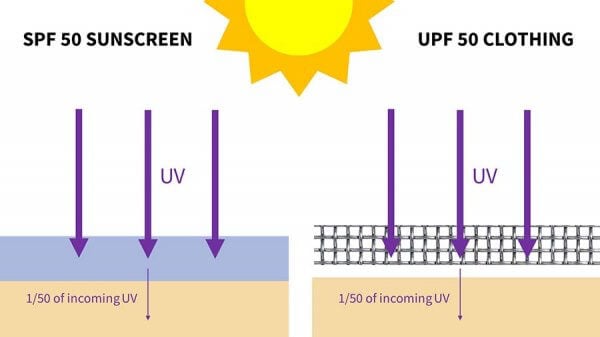
Related post: What Does SPF Mean? The Science of Sunscreen
(The difference between UPF and SPF is that with an SPF 50 sunscreen, it only lets in 1/50th of the sunburn-causing UV if you’ve applied it evenly at 2 mg/cm2; with UPF, what you see on the label is what you get, although the UPF of your clothes can change over time which we’ll talk about a bit later.)
How is UPF measured?
The UPF of clothing is determined by a standardised test. The amount of UV that passes through fabric (the transmittance) is measured in a lab by instruments, without using human skin (unlike the clinical study used for SPF). UPF is a measure of erythemal (sunburn-causing) UV, which is a mix of UVA and UVB, so scientists measure the UVA and UVB transmitted separately, then convert it to UPF mathematically.
Here’s another difference from SPF: you usually get higher protection than the labelled UPF when you’re wearing the clothing under real life conditions. UPF is measured with UV hitting the fabric straight on, but when you’re actually wearing clothes a lot of UV is coming at your clothes at an angle, which means less UV passes through. So you can think of the UPF as a safe, “minimum” protection rating.
A few extra notes on UPF:
- The UPF rating is for the skin covered, for the entire item
- Some clothing is ineligible for UPF ratings if it doesn’t cover a certain amount of the body (e.g. bikinis and singlets)
- Some places have limits on how high a UPF rating can be claimed. For example, the maximum UPF rating that can be claimed in Australia is UPF 50+ (just like for sunscreen, which has a maximum rating of SPF 50+)
Non-UPF Clothing
So with UPF rated clothing, you know what protection to expect. But even though most clothes don’t have UPF ratings, regular clothing can still protect your skin from UV to some extent – tan lines are evidence of this!
Unfortunately, many fabrics don’t provide a lot of UV protection. In one survey, one third of summer clothes gave less than UPF 15 protection.
So what sorts of clothing tend to protect best from UV?
It can be difficult to compare clothing because there are a lot of different variables that affect UV protection, and some of these variables are things you can’t easily work out just by looking at the clothing (which is one of the big advantages of UPF-labelled clothing). So if you’re looking for UV-protective clothing, you’ll have the best chance if you try to tick off as many of these boxes as possible.
Type of material
The type of material makes a big difference to UV protection.
In general, natural fibres like cotton, linen, viscose and rayon aren’t very UV absorbent. One study found that samples of white cotton, rayon and linen all gave UPFs below 5. Even tightly woven heavy natural fabrics had low UPFs below 20!
Wool, nylon and silk are better at protecting against UV.
Polyester is particularly good at absorbing UVB due to its structure, which contains benzene rings (these absorb UV and are present in lots of sunscreen actives). Polyester usually has 3 to 4 times the UPF of cotton, given similar types of fabrics (weight, weave). In the same study, polyester samples gave UPFs of 12 to 77.
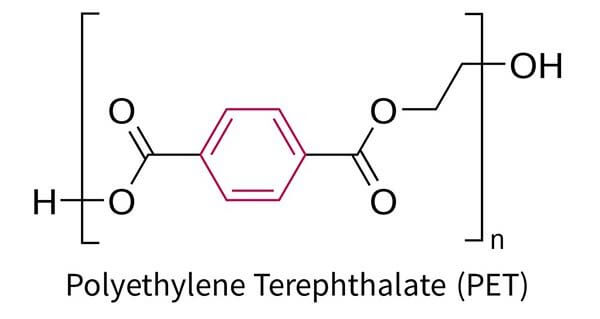
However, polyester gets sweaty in summer. Polyester blends can be used instead – the UV protection is diluted, but the clothes are much more wearable. Newer generation sports clothes are often made of polyester blends with multiple layers of fabric and usually have very high UPF values – some professional soccer clothes are over UPF 100!
Fabric construction etc.
Fabric isn’t solid though, so UV can pass through the holes in the fabric. So the factors that change how many holes there are and the size of the holes make a huge difference to the UV protection you get – there are a whole bunch of factors involved here! You can roughly estimate this by looking through the cloth and seeing how much light gets through – the less light gets through, the less UV can get through the holes in the fabric.
First there’s the thickness of the fibres. As you’d expect, thicker fibres are more protective. There’s also the way that the yarn is spun, with more twisted fibres giving higher protection (the fabric gets more compact as the yarn untwists).
Then there’s the construction of the fabric, which is how it’s turned from a string into a flat piece of cloth. Knitted fabrics (where the pattern gives some stretch, e.g. used in T-shirts) is usually better than woven fabrics (where the pattern gives no stretch e.g. used in more formal shirts). This is because knitted fabrics tend to have smaller holes for UV to get through.
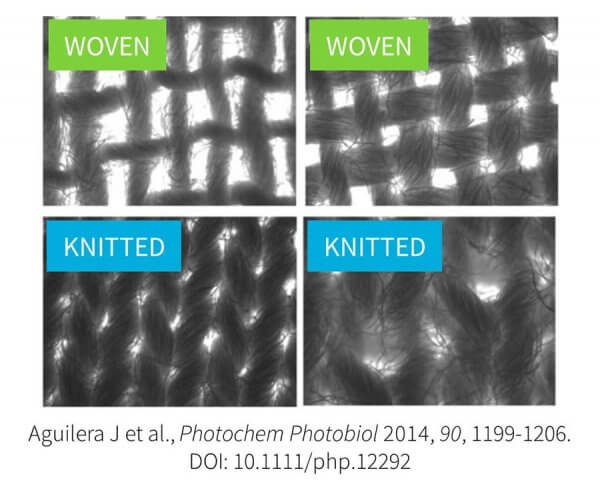
Laundering makes a difference as well. Some fabrics shrink a bit in the wash, and this means that the holes shrink too. This happens a lot with cotton. In studies the UV protection has gone up by ⅕ to double the UPF after 5 to 10 washes, because the size of the holes decreased.
On the other hand, after you wash your clothes too much, they might get worn out as they lose threads in the wash and as you wear them down, which leads to a lower weight fabric with less UV protection.
In general, heavier and thicker cloth will give more UV protection. Denim gives a UPF of 1700, while a typical summer cotton T-shirt has a UPF of 5 to 9. Thin 15 denier stockings only give a UPF of less than 2.
Colour
Coloured fabrics have higher UV protection. This isn’t surprising if you look at the structure of dyes – they have lots of benzene rings which is how they absorb coloured light (which is what gives them their colour), but it means they can also absorb in the UV region (sunscreen actives also have lots of benzene rings).
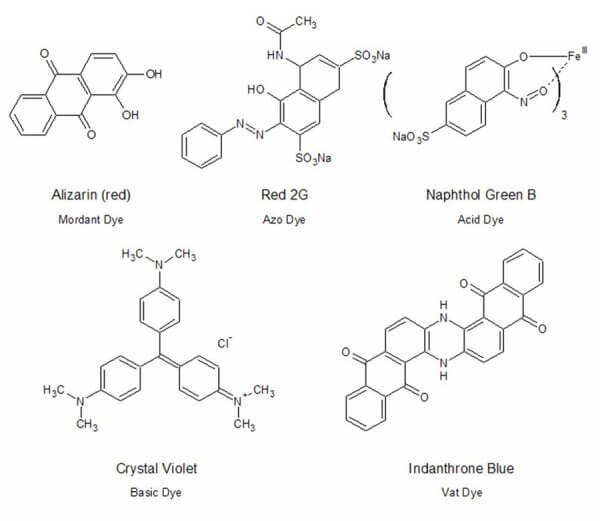
Bleached fabrics have the worst UV protection, since any natural dyes in the fibre are destroyed. Unbleached fabrics are better. The best UV protection comes from high concentrations of dye in your fabric.
- In one study, dyeing fabrics dark blue increased the SPF by more than three times for all cotton fabrics.
- In another study, dyeing the fabric blue increased the UPF by 544%, while yellow gave a 212% increase (blue dye was more effective than using a special UV treatment on the fabric).
In different studies dark colours always performed well, but sometimes lighter colours worked well too (e.g. white, beige, red, green).
- The effect of dye is greater with denser fabrics, since dye sits in the fibres of the fabric.
- Again, with wear, UV protection can change as the dyes fade (since less dye means less protection).
- Different types of dye had different levels of protection, but this is difficult to work out from just looking at the fabric.
Types of clothes
In general, given their fabric type and colours, shirts have lower UPF. Higher UPFs were found for dresses, t-shirts, polo t-shirts and polyester-blend sportswear (particularly if they came in dark colours).
Now on top of the fabric you choose, there are other things that can change the UPF level when it comes to clothes:
Treatments
Your clothes can wear sunscreen, and just like with sunscreen this can be organic or inorganic. Polyester has built in sun protection, but during production, different additives can also be combined with the fibre, including zinc oxide, titanium dioxide and nanodiamond.
You can also treat clothing after you take it home, with products like Rit Sun Guard. This contains Tinosorb FD, and one laundry cycle with Sun Guard gives clothing UPF 30 protection for 20 future washes (it works best with natural fibres).
Stretching
If you stretch a piece of fabric, the holes get bigger and UV passes through more easily, giving lower UPF.
It doesn’t take much stretching to get a much lower UPF – the decrease depends on the direction of stretch, and the type of fabric involved:
- A 15% stretch in cotton/lycra fabric halves the UPF
- A 30% stretch of a stocking decreases the UPF to 1/9th of the original
To prevent this loss of UV protection, it’s best to avoid tight fitting clothing especially if it’s made of a stretchy material, and choose a looser fit instead.
Dryness
With wet clothing, you can get lower OR higher protection, and it seems to be pretty much impossible to predict which way it goes.
The UPF of cotton clothing tends to decrease when it’s wet, with a typical summer cotton T-shirt going from UPF 5-9 to UPF 3-4.5 when wet.
UPF clothing vs regular fabrics
So for high UV protection, what you’re looking for is generally synthetic fabrics that are tightly woven with as little holes as possible in intense colours (particularly dark colours), covering as much of your skin as possible. Unfortunately that’s the opposite of what’s comfortable to wear when you’re active and sweaty in the sun in summer.
That’s the biggest advantage of UPF clothing, in my opinion – with things like UV absorbing treatments and UV absorbing technology in the fibre material, you can wear comfortable protective clothing in summer while getting a guaranteed level of sun protection.
You can also cut down how much skin you need to reapply sunscreen to, and not worry so much about getting enough sunscreen on hard-to-reach places.
UPF clothing reviews
Here are some brands of UPF clothing I’ve personally tried:
Uniqlo UV Range
Uniqlo are probably my favourite clothing brand – at any one time I’m usually wearing at least 2 pieces of clothing from Uniqlo! They have a very limited range of UV protective clothing, but it’s very affordable.

I particularly like the UPF 50 protective clothing from the Airism range, which is designed to feel light and cool on the skin. To achieve this high protection, Uniqlo has added special filters to the UV Cut fabrics which block and reflect UV at the fibre level.
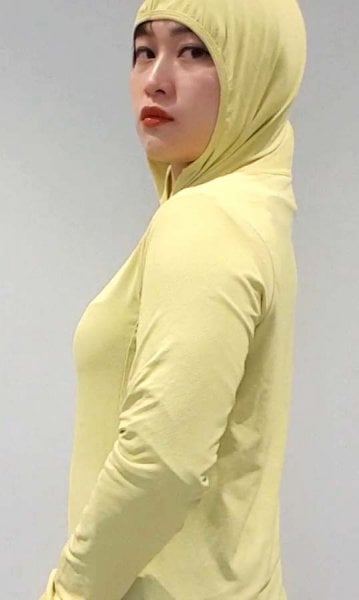
The hoodie I have has thumbholes, a common feature in UV protective clothing that gives some UV protection to the backs of your hands – unfortunately it also means that the palm of your hand is quite slippery, and this is the actual hoodie that made me crack my phone screen. The pocket size is also a bit small for a standard sized phone to stay comfortably in.
Mecca Rash Vest
Rash vests were decidedly Not Cool when I was a kid – you’d wear these stretchy neon shirts with lurid designs for swimming lessons, and then when you became a teenager they immediately came off.
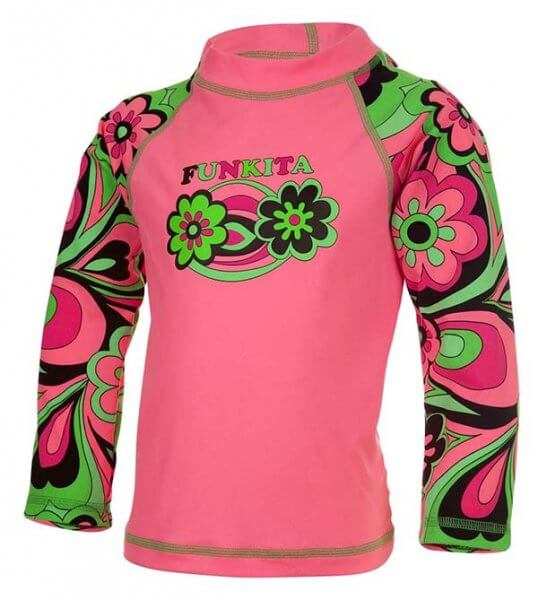
But there are much more fashionable designs now! Mecca Cosmetica released a very wearable rash vest design last summer. It’s rated UPF 50 and is made from stretchy nylon elastane. I’ve worn it at the beach and felt very fashionable, and very smugly enjoyed the fact I didn’t have to rub sandy sunscreen into my skin.
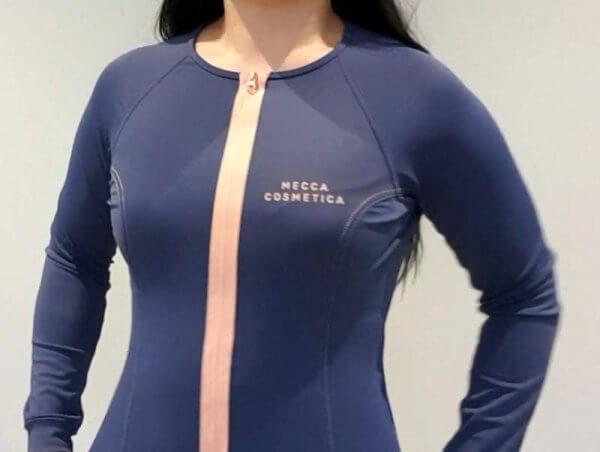
Solbari Clothing
Solbari are an Australian brand that entirely focus on sun protection. Their range is UPF 50+ and tailored and fitted, and goes from very fashionable to possibly a bit avant garde, depending on how much sun protection you need and what you’re comfortable wearing (masks are probably more acceptable now than they used to be, pre-pandemic, and a lot of face masks don’t give good sun protection).
Solbari clothing has a lot of nifty sun-protective features like thumb holes for extra protection on the backs of your hands, and collars with extra fusing to enhance neck protection.
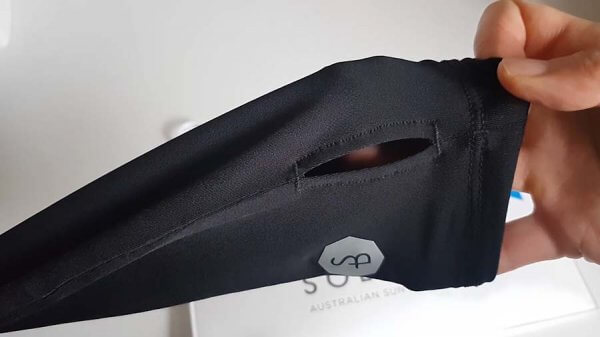
Their clothing comes in a few different fabrics that are created to be cooling, breathable, moisture wicking, or anti-odour.
Solbari’s Sensitive fabric is great if you have sensitive skin that’s also sun sensitive. It’s made with blend of organic cotton and bamboo, which gives a high UPF but also regulates body temperature to avoid extra irritation from heat and moisture. There aren’t any added chemicals that come off from the clothing, so it’s good for chemical sensitivity as well. I really like their Luxe Sun Wrap, which is a nice long cardigan-type top.
They also have the Coolasun fabric, which gives a cool feel on the skin even with dark colours that would normally feel hot in the sun – even their long sleeved turtleneck feels cool!
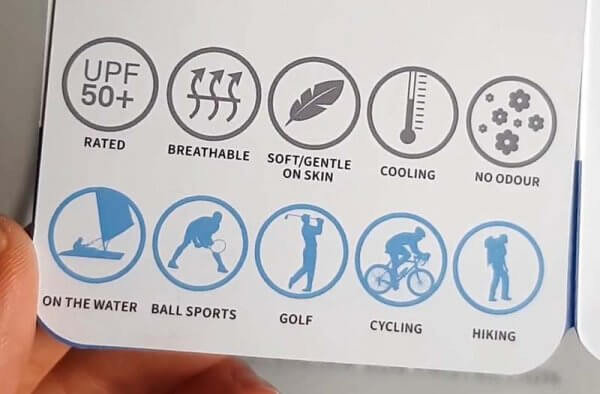
I particularly like their protective arm sleeves – you can wear these with any t-shirt to get extra protection on your arms.
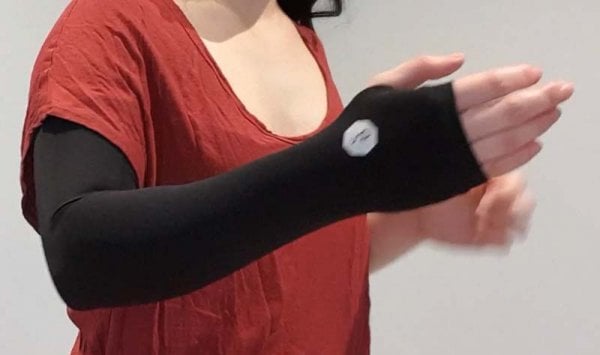
Coolibar is a similar brand that’s based in the US – they make more use of embedded zinc oxide and titanium dioxide in their fabrics to achieve high UV protection.
Do you wear UV protective clothing? What recommendations do you have?
Note: I usually only list the most relevant references, but I’ve been told that some people judge the accuracy of information by the number of references listed (which is bizarre if you’ve ever tried doing a literature review – one good study is worth more than 15 dodgy ones!), so I thought it would be interesting to list all the references I used and see how it looks (I skipped the ones that I read but didn’t end up relying on much, and I definitely forgot to include a bunch). I’d consider this topic one of the easier ones to research.
I’m hesitant to keep doing this because formatting references takes hours (even though I lazed out on actually linking most of these), and I think that time could be better used on a lot of other things. The first references listed are still the most useful, comprehensive ones, and I always try to include some open access information.
References
Gambichler T et al., Protection against ultraviolet radiation by commercial summer clothing: need for standardised testing and labelling, BMC Dermatol 2001, 1, 6. DOI:10.1186/1471-5945-1-6.
Kan CW, Au CH, In-Vitro Analysis of the Effect of Constructional Parameters and Dye Class on the UV Protection Property of Cotton Knitted Fabrics, PLoS One 2015, 10, e0133416. DOI:10.1371/journal.pone.0133416
Wang SQ et al., Reduction of ultraviolet transmission through cotton T-shirt fabrics with low ultraviolet protection by various laundering methods and dyeing: clinical implications, J Am Acad Dermatol 2001, 44, 767-74. DOI: 10.1067/mjd.2001.112384.
Stanford DG et al., Sun protection by a summer-weight garment: the effect of washing and wearing, Med J Aust 1995, 162, 422-5. DOI:10.5694/j.1326-5377.1995.tb139972.
Sinclair SA & Diffey BL, Sun protection provided by ladies stockings, Br J Dermatol 1997, 136, 239-41.
Davis S et al., Clothing as protection from ultraviolet radiation: which fabric is most effective? Int J Dermatol 1997, 36, 374-9. 10.1046/j.1365-4362.1997.00046.x.
Aguilera J et al., New advances in protection against solar ultraviolet radiation in textiles for summer clothing, Photochem Photobiol 2014, 90, 1199-206. DOI:10.1111/php.12292
Osterwalder U et al., Facts and ficton on ultraviolet protection by clothing, Rad Protect Dosimetry 2000, 91, 255–259. DOI: 10.1093/oxfordjournals.rpd.a033213
Kan CW et al., The Effect of Stretching on Ultraviolet Protection of Cotton and Cotton/Coolmax-Blended Weft Knitted Fabric in a Dry State, Materials (Basel) 2013, 6, 4985-4999. DOI:10.3390/ma6114985
Clark IES et al., Clothing Protection Measurements, Rad Protect Dosimetry 2000, 91, 279–281. DOI: 10.1093/oxfordjournals.rpd.a033218
ARPANSA, The Australian standard for sun protective clothing AS4399:2020, 2020.
Crews PC et al., Influences on UVR transmission of undyed woven fabrics, Text Chemist Colorist 1999, 31, 17–26.
Alebeid OK & Zhao T, Review on: developing UV protection for cotton fabric, J Textil Inst 2017, 108, 2027-2039. DOI: 10.1080/00405000.2017.1311201
Wong WY et al., Influence of knitted fabric construction on the ultraviolet protection factor of greige and bleached cotton fabrics, Textil Res J 2013, 83, 683–699. 10.1177/0040517512467078
Khazova M et al., Radiation and chemical degradation of UVR protection characteristics of fabrics, Rad Protect Dosimetry 2007, 123, 369–377. 10.1093/rpd/ncl151
Gambichler T, Hatch KL, Avermaete A, et al., Ultraviolet protection factor of fabrics: comparison of laboratory and field-based measurements, Photodermatol Photoimmunol Photomed 2002, 18, 135-140. DOI:10.1034/j.1600-0781.2001.00739.x
Kan CW, A study on ultraviolet protection of 100% cotton knitted fabric: effect of fabric parameters, ScientificWorldJournal 2014, 506049. DOI: 10.1155/2014/506049.
Sarkar AK, On the relationship between fabric processing and ultraviolet radiation transmission, Photodermatol Photoimmunol Photomed 2007, 23, 191-6. DOI: 10.1111/j.1600-0781.2007.00306.x.
Mecca Cosmetica and Solbari products were provided as PR samples for editorial consideration, which did not affect my opinion. This post also contains affiliate links – if you decide to click through and support Lab Muffin financially (at no extra cost to you), thank you! For more information, see Disclosure Policy.


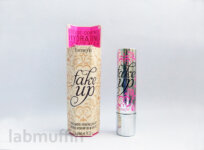

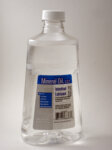
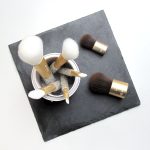
I’m so glad you did a piece (a very thorough one!) on UC protective clothing. Personally, I prefer it to slathering myself with sunscreen. But I run cool too. My current favorite long sleeved tee shirt that’s uv protective is by Patagonia. It’s a cool feeling shirt, despite the long sleeves. I got it here: https://www.patagonia.com/product/womens-long-sleeved-capilene-cool-daily-shirt/45185.html?dwvar_45185_color=FEA&cgid=collections-sun-protection-womens
I have lupus and have been wearing sun protective clothing for decades now. My favorite by far is Solumbra. They have strategically placed vents and mesh that make them very comfortable to wear in the heat. In fact, if I am in full sun, I feel cooler in a long-sleeve Solumbra shirt than I do in a tank top. They are pricey but they last forever, and I don’t have to go through gallons of sunscreen to spend a day out hiking or gardening.
I have that same Uniqlo hoodie (in blue) and a Cancer Council long-sleeved rashie.
When I go horseriding I usually wear a thick cotton long-sleeved collared shirt and riding gloves to protect the backs of my hands. These plus my jodhpurs, boots and helmet makes me really hot so I end up riding as late as possible in the day instead. I recently found a riding shirt with UPF 50, plus some sort of cooling technology so I’ll be keen to try that.
I love UPF clothing for the kids and have a shirt for myself for when I am at the beach or snorkeling – not pretty, but very effective.
Hey Anne,
I’m too living in germany. Where do you buy uv clothing, if not on amazon….? Thank you!
Ironically, I’ve only ever glanced at the references and I don’t concern myself much with that LOL. I judge you (or anyone) based on their actual content and intellect, from watching/reading many posts. You’ve proved yourself many times over, don’t stress about what a few people think.
Hi,
do you know how it works that uniqlo sells uv clothes for 25€ and solbari takes for leggins 67€? Could it be that uniqlos aren’t that good? I think they hace to save somewhere to be able to sell them for 1/3 of the price from an only uv protection brand.
Would love to hear your opinion!
Ciao
Hi! I know this is almost 3 years late :))
I think the reason why Uniqlo’s is much cheaper is because of economies of scale. They are a much bigger business and produce in a much larger scale so have a significantly reduced cost compared to solbari.
Regards 🙂
Great article, thanks for having so many awesome references. You can cut down the time it takes to do citations by using the website http://www.citationmachine.net It’s free, easy to use and awesome! I use it for college papers. 🙂
Thanks for all your research!
Just really impressed by such thoroughly presented science. Thanks!
you just saved me tons of research time and some money.
For now I am using silk haori kimono as a go-to topper in the summer that goes over all my regular clothes but I think I need to get a long sleeve top. I was not sure if regular 100% polyester at 14$ is as good at protecting as a brand name at 85$ (same material different labels). Your article answered that question for me.